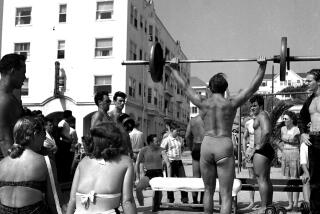Adults Need Exercise, Kids Need Activity
- Share via
Trying to transform your children into a more active, healthy types but can’t seem to nudge them from the couch?
You have company.
Inertia and pudginess can set in early among American youth, studies suggest. About 40% of children, ages 5 to 8, have an inactive lifestyle, high blood pressure, obesity or a combination of these risk factors for early heart disease, says Lani Graham, program coordinator of the National Assn. for Sport and Physical Education, citing research by her group and the President’s Council on Physical Fitness.
In a 1989 study, 70% of girls and 40% of boys, ages 6 to 12, did not have enough muscular strength to do more than one pull-up, Graham says. Other researchers have found that children today weigh more and have more body fat than children did two decades ago and that childhood obesity is on the rise.
Exercise experts have discovered some strategies to get kids moving. They stress the importance of an exercise program that’s fun, not regimented and compulsive.
If you doubt the fun factor can work, consider the success of a new video, “Dance! Workout with Barbie.”
Soon after its April debut, the $20 home video quickly jumped onto the Video Business best-seller list. During the 30-minute tape, an aerobics instructor leads a group of 7- to 11-year-old girls through the mostly low-impact dance moves, cutting away to a Claymation version of Barbie for periodic encouragement.
“It sounds like the music and dancing would attract them,” says Larry Gettman, a Phoenix exercise physiologist who chairs the American Council on Exercise, a nonprofit research and educational organization. “It sounds more like MTV” than hard work, he adds.
“Barbie is an inspiration to girls that age, a role model,” says Lorna Francis, an assistant professor of physical education at San Diego State University and a nationally known exercise expert.
Aerobic dance routines for children are safe if they are monitored, says a spokeswoman for the Aerobics & Fitness Assn. of America, an organization that trains aerobics instructors and gave its seal of approval to the Barbie video.
“Children who engage in aerobics are less likely than adults to suffer injuries because they are more limber,” she says, “but they should be warned not to lock knees or overextend their limbs. They should always cool down.”
Besides encouraging exercise that’s fun, parents should quell the urge to call it “exercise,” experts advice. In lieu, refer to it as “activity.”
“Exercising for exercise’s sake is not that attractive to kids 7 to 11 years old,” says Francis. “But exercising as part of a sport or family activity is more interesting. It’s hard to get kids to go run a mile every day for exercise,” Francis finds. “But if they (choose to) run a mile for a soccer program, that’s more interesting.”
As director of a walking program at her own children’s elementary school, Francis has found that the buddy system for exercise adherence seems to work as well for children as it does for adults. Each weekday, there is a 20-minute walk before school starts.
“Nearly half of the children walk 75% of the time,” she says, “and another 30% are sporadic participants. It’s completely voluntary and non-competitive.” The walkers add up their cumulative mileage and trace their imaginary route on a huge U.S. map in the school auditorium. Incentives are given after certain mileage points, with children who participate at least 75% of the time receiving such perks as free T-shirts or buttons.
The perks work better, Francis says, than educating kids to focus on the benefits of exercise as a motivator. If you exercise together as a family, stifle the urge to foster competition between parents and children or between siblings. If your child participates in school-sponsored sports, there may already be too much emphasis on competition, some experts say.
The goal of parents should be to foster a love of physical activity well into the adult years. Parents who are active themselves are more likely to teach the lesson. The more active the parents, the more likely the children will be physically active, several studies have shown.
Staying active does not have to be costly, adds Steve Block, president of Sports Performance and Rehabilitation Institute (SPERI) Products, an Illinois firm that makes inexpensive exercise equipment.
“The whole key is to make it fun in a game-type atmosphere,” he says. His Quik-Fit for kids, for instance, is a $6 piece of rubber tubing that helps children strengthen muscles.
Physical inactivity isn’t entirely a child’s fault, Francis and other experts note. “Kids need more opportunities to be active,” Francis says. Often, young kids are told to stay home after school, bikes locked up, until a parent gets home from work. By the time parental supervision is available, it’s dinner time or dark.
MIXING IT UP: Range of Activities Give Best Results
If your child engages in only one form of physical activity, encourage variety, suggest experts at the American Academy of Pediatrics.
It’s important to participate in a range of activities to help build all five components of physical fitness: aerobic fitness, body composition, muscular strength, muscular endurance and flexibility.
A child who plays volleyball, a non-aerobic sport, should consider aerobic activity such as swimming, the academy suggests.
If you’re after aerobic fitness, try cycling, running, walking.
For body composition, try cycling, running, cross-country skiing.
For muscle strength, try gymnastics, running.
For muscle endurance and flexibility, try figure skating, gymnastics.
Suggested Reading: “Kid Fitness: A Complete Shape-Up Program From Birth Through High School,” by Dr. Kenneth Cooper (Bantam Books, $19.50).






